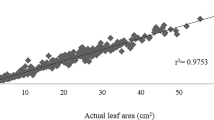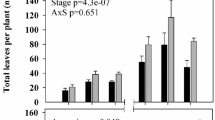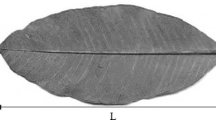Abstract
Accurate and non-destructive methods to determine the plant leaf area are important measurements used in physiological and agronomic studies. This study was aimed to develop the best estimation model in 2017 to determine leaf area in some apple varieties of ‘Summerred’, ‘Mondial Gala’, ‘Golden Delicious’ and ‘Braeburn’ by using leaf length (L), width (W) and combination of the two parameters. Sixteen different models composed of linear and power were obtained. High coefficient of determination denoted R2 and low mean square error (MSE) values were used to determine the best models to estimate. Accordingly, combinations of L × W parameters for ‘Summer Red’ and ‘Mondial Gala’ varieties and L × W2 for ‘Golden Delicious’ and ‘Braeburn’ varieties were determined as the efficient parameters in estimation of plant leaf area. The results revealed that the plant leaf area can be estimated in an inexpensive, fast and non-destructive manner by mathematical relationships obtained with high R2 (‘Summer Red’: 97.9%; ‘Mondial Gala’: 99.1%; ‘Golden Delicious’: 98.6%; ‘Braeburn’: 95.1%) and low MSE (‘Summer Red’: 8.48; ‘Mondial Gala’: 1.594; ‘Golden Delicious’: 0.005; ‘Braeburn’: 0.013) values using leaf dimensions of each variety rather than expensive measurement instruments.
Similar content being viewed by others
Avoid common mistakes on your manuscript.
Introduction
Leaf is the most important photosynthetic organ of plants and affects plant growth and bio-productivity. Leaf area also is a valuable parameter for studies such as plant nutrition, plant protection, plant soil-water relations and ecosystem. Accurate, fast, and non-destructive leaf area measurement is important in plant research on understanding and modeling of ecosystem functions (Li et al. 2007). Plant physiologists and agronomists indicated the importance of this parameter in estimation of plant growth, growth rate, yield potential, radiation utilization efficiency and water and nutrient utilization (Bhatt and Chanda 2003; Williams III and Martinson 2003; Cristofori et al. 2007). The measurement of plant leaf area is a decisive factor in understanding the physiological conditions such as photosynthesis, light interception, water and nutrient uses and yield potential (Clayton et al. 1995; Demirsoy and Lang 2010). However, measuring the leaf area is a time-consuming and costly process, depending on methods used and/or sensitivity demanded (Sala et al. 2015).
The leaf area estimation is an important criterion in many physiological and agronomic studies; thus, easiness and reliability of measurement method are very important criteria. Therefore, leaf area measurements are divided into direct and indirect methods (Çelik et al. 2011). Indirect leaf area measurement is an inexpensive method in which leaf area is calculated using simple mathematical methods and requires less time than direct measurement methods (Gamiely et al. 1991; Demirsoy and Demirsoy 2003). Villalobos et al. (1995) recommended indirect measurements for the leaf area measurements of perennial plants in contrast to annual plants due to high labor and long time required by direct methods. Similarly, many researchers have also reported that indirect measurement methods have more advantageous than direct methods (Robins and Pharr 1987; Elsner and Jubb 1988; Kersteins and Hawes 1994, Sousa et al. 2005).
The aim of this study was to obtain an estimation model for leaf area and determine the mathematically expression of leaf area calculation by using the leaf width and height measurement values of samples collected from ‘Summer Red’, ‘Mondial Gala’, ‘Golden Delicious’ and ‘Braeburn’ apple varieties grafted on MM.106 semi-dwarf apple rootstock.
Material and Methods
The study was carried out in 2017 on the leaf samples collected from ‘Summer Red’, ‘Mondial Gala’, ‘Golden Delicious’ and ‘Braeburn’ apple varieties grafted on MM 106 semi-dwarf apple rootstock in Kirsehir province. The leaf samples were taken from the apple trees during the growth period. The leaves were randomly chosen from the branches located at different heights of the trees. A total of 500 leaf samples, 125 for each apple variety, were taken for the study.
The leaf samples were brought to the laboratory in ice bags, and width and lengths of leaves were measured using a ruler from the longest and largest parts (Fig. 1) according to the methods reported in several literature (Blanco and Folegatti 2003, Demirsoy et al. 2004, Cristofori et al. 2008, Sala et al. 2015). Then, the leaf areas of leaves were calculated by 3 repetitive calculations using a Placom Intelligent Planimeter.
Statistical Evaluation
Sixteen different models were obtained for the leaf area estimation of 4 different apple varieties using the independent variables of leaf width (W) and height (L) values and the combinations of L2, W2, L × W, L2 × W, L × W2, L2 × W2. The relationships between the leaf area and these variables were examined in two different ways as linear [\(Y=\beta _{0+}\beta _{1}(t)\)] and power [\(Y=\beta _{0}(X^{{\beta _{1}}})\)]. High coefficient of determination, denoted R2 and low mean square error (MSE) values were used as criteria (Tsialtas et al. 2008) in determining the best estimation model among the estimated models. Equational expansions of these statistical criteria were given in Eqs. 1 and 2 (Atıl and Akıllı 2016; Tüzemen and Yıldız 2018). .
In equations; Yi shows the observed value, \(\hat{Y}_{i}\): is the predicted value (= 1,2,3..., n), \(\overline{Y}\): is the mean, n: is the number of observations.
Results
The study was conducted using ‘Summer Red’, ‘Mondial Gala’, ‘Golden Delicious’ and ‘Braeburn’ apple varieties. Descriptive statistics of the four different apple varieties were given in Table 1. The mean leaf length, leaf width and leaf area values were 8.648 cm, 4.733 cm and 31.766 cm2 for ‘Summer Red’, 7.14 cm, 4.560 cm and 23.956 cm2 for ‘Mondial Gala’, 8.588 cm, 5.085 cm and 31.947 cm2 for ‘Golden Delicious’ and 6.895 cm, 4.208 cm and 21.873 cm2 for ‘Braeburn’ variety.
The estimation equations obtained for apple varieties were given in Table 2, 3 and 4 and 5 based on tested model structures. The best estimation model for the ‘Summer Red variety was Model 5 obtained by the linear regression. The highest R2 (97.9%) and lowest MSE (8.48) values compared to the other models tested were obtained for Model 5 with the L × W independent variable. In addition, the best estimation equation for ‘Summer Red’ was Y = 0.737x − 1.371 (Table 2). The relationship between measured and the predicted values were shown in Fig. 2. The predicted values were quite close to the actual values in comparison to the linear equation of Model 5 (Fig. 2).
The best estimation model for the ‘Mondial Gala’ variety was determined as Model 5 obtained by the linear regression (Table 3). The Model 5 with L × W independent variable had the highest R2 (99.1%) and the lowest MSE (1.594) values compared to the other models tested. The best estimation equation for the ‘Mondial Gala’ variety was y = 0.720x − 1.099. The measurement and estimation values were shown in Fig. 3. The R2 value was very close to 1.0 (Fig. 3).
The best estimation model for the ‘Golden Delicious’ variety was Model 15 which is a power model. The highest R2 (98.6%) and lowest MSE (0.005) values compared to the other models tested were obtained for Model-15 with the L × W2 independent variable. In addition, the best estimation equation for ‘Golden Delicious’ was y = 0.675 × 0.773 (Table 4; Fig. 4).
Similar to the Golden Delicious variety, the best estimation model for the ‘Braeburn’ variety was Model 15 which was obtained according to the power model. The highest R2 (95.1%) and the lowest MSE (0.013) values compared to the other models tested were obtained for Model 15 with the L × W2 independent variable. In addition, the best estimation equation for ‘Braeburn’ was y = 0.657 × 0.884 (Table 5; Fig. 5).
Discussion
The best estimation of leaf area for the ‘Golden Delicious’ and ‘Braeburn’ apple varieties was obtained by linear, while the best estimation of leaf area for the ‘Summer Red’ and the ‘Mondial Gala’ apple varieties were obtained by power equation. Horticulturalists and agronomists need an inexpensive, fast, reliable, and non-destructive method to measure the leaf area (Blanco and Folegatti 2003, Peksen 2007; Olfati et al. 2010, Küçükönder et al. 2016). Therefore, the results indicated that mathematical models arising from the relationships between leaf area and leaf dimensions (length and width) can be used to determine the apple leaf area as a faster and more practical method compared to the other expensive leaf area estimating methods.
Several mathematical models using leaf dimensions have been developed estimating the leaf area indirectly in various crops, such as apple (Palmer 1987; Sala et al. 2015; Clayton et al. 1995), grapes (Montero et al. 2000; Beslic et al. 2010), cherry (Demirsoy and Demirsoy 2003, Demirsoy and Lang 2010), chestnut (Serdar and Demirsoy 2006), coconut (Sousa et al. 2005), hazelnut (Cristofori et al. 2007), peach (Demirsoy et al. 2004), Persimmon (Cristofori et al. 2008), olive (Villalobos et al. 1995) tomatoes (Küçükönder et al. 2016), cucumber (Cho et al. 2007), onion (Gamiely et al. 1991), cabbage and broccoli (Olfati et al. 2010).
The results obtained in this study are consistent with the results of researchers who developed reliable equations to estimate the leaf area with non-destructive models using simple linear leaf dimension measurements. The results revealed that the coefficient of determination between predicted values calculated with the mathematical models and the leaf areas determined by the actual measurement was quite close to 1.0. This high correlation pointed out that the leaf width and length parameters were effective in estimating the apple leaf area, and therefore the leaf area could be estimated using these parameters. Similar results on leaf area estimation models have been reported by many others (Montero et al. 2000; Blanco and Folegatti 2003; Çelik et al. 2011; Rouphael et al., 2010; Sala et al. 2015). The strong relationships indicated that leaf areas of apple varieties can be measured quickly, accurately, and non-destructively.
Conclusion
This study introduced the mathematical equations created from the leaf length and width measurements for ‘Summer Red’, ‘Mondial Gala’, ‘Golden Delicious’ and ‘Braeburn’ apple varieties. The equations of Y = 0.737x − 1.371 for ‘Summer Red’ variety, Y = 0.720x − 1.099 for ‘Mondial Gala’, Y = 0.675 × 0.773 for ‘Golden Delicious’ and Y = 0.657 × 0.884 for ‘Braeburn’ variety can be used for the most accurate estimation of leaf area.
The results indicated that the estimation of plant leaf area can be achieved in an inexpensive, fast, and non-destructive manner using mathematical relationships obtained with high R2 and low MSE values using leaf dimensions of each variety rather than using expensive measurement instruments.
References
Atıl A, Akıllı A (2016) Comparison of artificial neural network and K-means for clustering dairy cattle. Int J Sustain Agric Manag Inf 2(1):40–52
Beslic Z, Todic S, Tesic D (2010) Validation of non-destructive methodology of grapevine leaf area estimation on cv. Blaufränkisch (Vitis vinifera L.). S Afr J Enol Vitic 31(1):22–25
Bhatt M, Chanda SV (2003) Prediction of leaf area in Phaseolus vulgaris by non-destructive method. Bulg J Plant Physiol 29(1–2):96–100
Blanco FF, Folegatti MV (2003) A new method for estimating the leaf area index of cucumber and tomato plants. Hort Bras 21(4):666–669
Çelik H, Odabaş MS, Odabas F (2011) Leaf area prediction models for highbush blueberries (Vaccinium crymbosum L.) from linear measurements. Adv Food Sci 33(1):16–21
Cho YY, Oh S, Oh MM, Son JE (2007) Estimation of individual leaf area, fresh weight, and dry weight of hydroponically grown cucumbers (Cucumis sativus L.) using leaf length, width, and SPAD value. Sci Hortic 111:330–334. https://doi.org/10.1016/j.scienta.2006.12.028
Clayton M, Amos ND, Banks NH, Morton RH (1995) Estimation of apple fruit surface area. N Z J Crop Hortic Sci 23:345–349. https://doi.org/10.1080/01140671.1995.9513908
Cristofori V, Fallovo C, Gyves EM, Rivera CM, Bignami C, Rouphael Y (2008) Non-destructive, analogue model for leaf area estimation in persimmon (Diospyros kaki L.) based on leaf length and width measurement. Eur Jhortsci 73(5):216–221
Cristofori VR, Gyves YEM, Bignami C (2007) A simple model for estimating leaf area of hazelnut from linear measurements. Sci Hortic 113:221–225. https://doi.org/10.1016/j.scienta.2007.02.006
Demirsoy H, Demirsoy L (2003) A validated leaf area prediction model for some cherry cultivars in Turkey. Pak J Bot 35(3):361–367
Demirsoy H, Lang GA (2010) Short communication. Validation of a leaf area estimation model for sweet cherry. Span J Agric Res 8(3):830–832
Demirsoy H, Demirsoy L, Uzun S, Ersoy B (2004) Non-destructive leaf area estimation in peach. Eur J Hort Sci 69:144–146
Elsner EA, Jubb GL (1988) Leaf area estimation of concord grape leaves from simple linear measurements. Am J Enol Vitic 39(1):95–97
Gamiely SR, Mills WMHA, Smittle DA (1991) A rapid and nondestructive method for estimating leaf area of onions. HortScience 26(2):206
Kersteins G, Hawes CW (1994) Response of growth and carbon allocation to elevated CO2 in young cherry (Prunus avium L.) saplings in relation to root environment. New Phytol 128:607–614
Küçükönder H, Boyacı S, Akyüz A (2016) A modeling study with an artificial neural network: developing estimation models for the tomato plant leaf area. Turk J Agric For 40:203–212. https://doi.org/10.3906/tar-1408-28
Li Z, Ji C, Liu J (2007) Leaf area calculating based on digital image. In: Computer and computing technologies in agriculture, vol II, pp 1427–1433
Montero FJ, Juan JA, Cuesta A, Brasa A (2000) Nondestructive methods to estimate leaf area in Vitis vinifera L. HortScience 35:696–698
Olfati JA, Peyvast G, Shabani H, Nosratie-Rad Z (2010) An estimation of individual leaf area in cabbage and broccoli using non-desturctive methods. J Agr Sci Tech Vol 12:627–632
Palmer JW (1987) The measurement of leaf area in apple trees. J Hort Sci 62:5–10
Peksen E (2007) Non-destructive leaf area estimation model for faba bean (Vicia faba L.). Sci Hortic 113:322–328. https://doi.org/10.1016/j.scienta.2007.04.003
Robins NS, Pharr DM (1987) Leaf area prediction models for cucumber from linear measurements. HortScience 22(6):1264–1266
Rouphael Y, Mouneimne AH, Ismail A, Mendoza-de Gyves E, Rivera CM, Colla G (2010) Modeling individual leaf area of rose (Rosa hybrida L.) based on leaf length and width measurement. Photosynt 48(1):9–15
Sala F, Arsene GG, Iordănescu O, Bodea M (2015) Leaf area constant modelin optimizing foliar area measurement in plants: A case study in apple tree. Sci Hortic 193:218–224. https://doi.org/10.1016/j.scienta.2015.07.008
Serdar Ü, Demirsoy H (2006) Non-destructive leaf area estimation in chestnut. Sci Hortic 108:227–230. https://doi.org/10.1016/j.scienta.2006.01.025
Sousa EF, Araújo MC, Posse RP, Detmann E, Bernardo S, Berbert PA, Santos A (2005) Estimating the total leaf area of the green dwarf coconut tree (Cocos nucifera L.). Sci Agric (piracicaba Braz) 62(6):597–600
Tsialtas JT, Koundouras S, Zioziou E (2008) Leaf area estimation by simple measurements and evaluation of leaf area prediction models in Cabernet-Sauvignon grapevine leaves. Photosynthetica 46:452–456. https://doi.org/10.1007/s11099-008-0077-x
Tüzemen A, Yıldız Ç (2018) Holt-winters forecast methods’ comparative analysis: Turkey unemployement rates implementation. Atatürk Üniv İkti İdari Bilim Derg 32(1):1–18
Villalobos FJ, Orgaz F, Mateos L (1995) Non-destructive measurement of leaf in olive (Olea europaea L.) trees using a gap inversion method. Agric For Meteorol 73:29–42
Williams III L, Martinson TE (2003) Nondestructive leaf area estimation of ‘Niagara’ and ‘DeChaunac’ grapevines. Sci Hortic 98:493–498. https://doi.org/10.1016/S0304-4238(03)00020-7
Funding
Not applicable
Author information
Authors and Affiliations
Contributions
Selma Boyacı: Field studies, leaf area measurements, discussion. Hande Küçükönder: Statistical analysis.
Corresponding author
Ethics declarations
Conflict of interest
S. Boyacı and H. Küçükönder declare that they have no competing interests.
Ethical standards
Consent for publication: If the study is deemed appropriate, there is no objection to its publication.
Ethics approval: An ethical document is not required for this research.
Additional information
Availability of data and material
The data was taken by me. It can be shared on demand.
Code availability
Not applicable
Rights and permissions
About this article
Cite this article
Boyacı, S., Küçükönder, H. A research on Non-Destructive Leaf Area Estimation Modeling for some Apple Cultivars. Erwerbs-Obstbau 64, 1–7 (2022). https://doi.org/10.1007/s10341-021-00619-w
Received:
Accepted:
Published:
Issue Date:
DOI: https://doi.org/10.1007/s10341-021-00619-w









